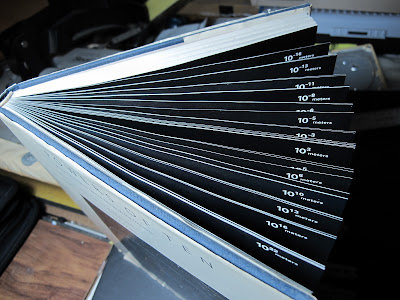Powers of Ten
I almost forgot! Today is 10/10/10. Numerologists all over the world are probably wetting themselves with excitement. Do I need to say that no, it really isn’t more significant than other days, despite the neat symmetry of its printed date?

One square meter
But it gives me a chance to talk about a picture book and film that changed how I understand the universe: Powers Of Ten. Both begin with a picture of a couple having a picnic in Soldier Field in Chicago. They’re laying on the grass and a square appears enclosing one meter. The picture changes with the addition of digits to the exponent, and it isn’t very many pages before we see the solar system, the galaxy, and at 1025m, a one-billion light-year chunk of the universe itself. With the little picnic still in the exact center.
But then the film returns (at considerably more than the speed of light) to the couple having their picnic, and begins delving into the surface of the man’s hand – subtracting one from the exponent each time, passing skin layers, capillaries, lymphocyte, DNA… until we see subatomic particles in a square 10-16m on a side.
The film was commissioned by IBM and produced in 1968 by Charles & Ray Eames. It has received tribute from the opening sequence of Men In Black and from an opening sequence of The Simpsons. It has inspired other books and films and not without reason; it is mind-blowing stuff. I don’t know why IBM commissioned the film. Maybe it was because their corporate slogan was “Machines should work; people should think” and years later the film has a proven record of provoking thought.
My dad took me to a showing at the University of Iowa at Iowa City and I don’t think I was ever the same after seeing it. You could hardly come away without thinking that our perspective is terribly occluded, and about what it means that we can now broaden our understanding of the universe with scientific instruments.
Evolution equipped our senses and perceptions to the physical, electromagnetic and temporal scale of our lives. From an evolutionary perspective there’s not much point in our being able to perceive subatomic particles or the moons of Saturn. Nor are our brains really equipped to grasp timelines that greatly exceed our lifespans, or which are briefer than, say, a thirtieth of a second. Our eyes evolved to use the narrow band between infrared, which isn’t that good for imaging with water-filled lenses, and ultraviolet, which is ionizing radiation and tends to damage biochemical sensors like rods and cones. But if you look at that little slice in proportion to the whole electromagnetic spectrum, we’re seeing, as Richard Dawkins quipped, through “the mother of all Burqas”.
The ancient Greeks were having none of it; just using sticks they calculated the Earth’s diameter to three decimal places, and figured out that we orbit the Sun. Galileo made telescopes, Leeuwenhoek microscopes, and as time passed many other scientific instruments and disciplines emerged to dig into things we could not see or grasp unaided. I found all this, to say the least, tremendously inspirational. Warped my mind pretty good, it did. It got me in the habit of owning microscopes, telescopes, and of always carrying a magnifying glass – a habit which persists to this day.
- Wikipedia: Powers Of Ten
- VIEW THE FILM HERE! (Thanks IBM for hosting the site) Call your kids into the room…
- Use an interactive ^10 demo at the Powers Of Ten home page. Simply click on the slider at left to control the zoom level.
- Powers Of Ten on Amazon – you can pick up a used copy for about three bucks plus shipping. Home schoolers, take note.
 (Click to embiggen)
(Click to embiggen)

Have ordered the book to send to my nephew, who was born 10-10-2000
His Tenth birthday gift will arrive a bit late, but a 10 year old should have plenty of time for reading.
There seems to be a fairly tight relationship between the nature of our senses and the nature of our intelligence(s). It seems both our senses and our intelligences are geared towards living as hunter/gathers within the context of a social groups. And both our senses and intelligences function adequately in those circumstances. But plop us down in some other range or set of circumstances, and we are the proverbial fish out of water.